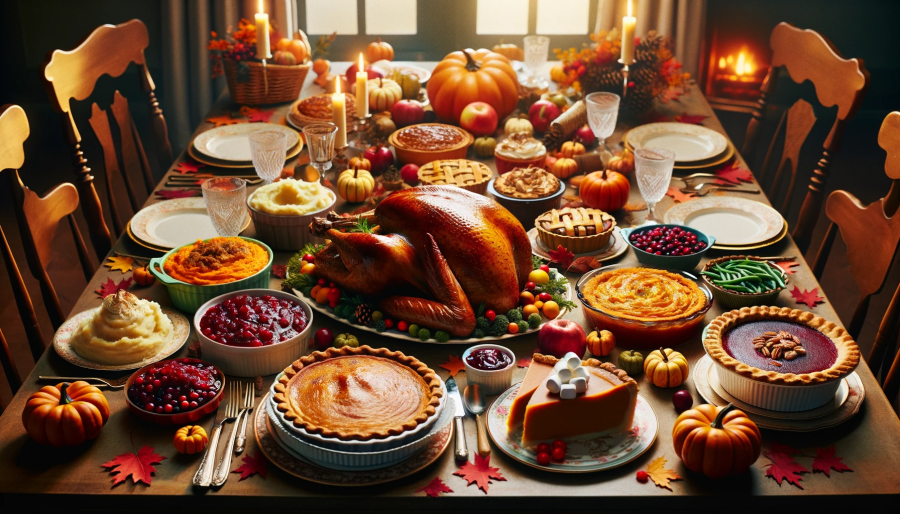
Thanksgiving, a day of gratitude, feasting, and family gatherings, stands as a cornerstone of American tradition. Its roots trace back to the early days of European colonization in North America, where a fateful harvest celebration between the English Pilgrims and the Wampanoag people marked the genesis of a holiday that would evolve over centuries.
The Pilgrims’ Harvest Feast: A Seed Sown in 1621
In the autumn of 1621, the Pilgrims, a group of English Separatists who had fled religious persecution in their homeland, found themselves in Plymouth, Massachusetts, struggling to survive in the harsh New World environment. Their first harvest proved bountiful, and in a spirit of gratitude, they invited their Native American neighbors, the Wampanoag, to share in a three-day feast.
This pivotal event, often referred to as the “First Thanksgiving,” laid the foundation for the holiday we celebrate today. The Wampanoag brought venison, corn, and other native foods, while the Pilgrims contributed their own harvest bounty. Together, they enjoyed a feast that symbolized harmony, mutual respect, and shared blessings.
From Harvest Celebrations to National Holiday
Over the following centuries, days of thanksgiving became a common practice among the various colonies and states in North America. These celebrations were often held to express gratitude for a successful harvest, a military victory, or other blessings. However, it wasn’t until 1863, during the tumultuous years of the Civil War, that President Abraham Lincoln proclaimed a national Thanksgiving Day.
Lincoln’s proclamation, issued on September 3, 1863, called for a day of “Thanksgiving and Praise to our beneficent Father who dwelleth in the Heavens” and urged Americans to express gratitude for the preservation of the nation despite the ongoing conflict. This marked a turning point in the holiday’s history, establishing it as a national observance.
Thanksgiving Feast: A Culinary Tapestry
The Thanksgiving feast has evolved over time, reflecting the diverse culinary traditions of America’s growing population. However, certain dishes have become synonymous with the holiday, each carrying its own unique history and significance.
The Majestic Turkey: A Centerpiece of Thanksgiving
The turkey has reigned supreme as the centerpiece of the Thanksgiving feast since the early days of the holiday. Its size, versatility, and association with harvest abundance made it a natural choice. The Pilgrims likely roasted turkeys during their harvest celebration, and by the 19th century, the turkey had become an established Thanksgiving staple.
Stuffing: A Savory Companion to the Turkey
Stuffing, also known as dressing, is another Thanksgiving classic, adding a savory complement to the turkey. Its origins can be traced back to ancient civilizations, where bread or grains were stuffed into poultry or other meats for flavor and moisture. The Pilgrims likely brought their own stuffing recipes from England, and over time, regional variations emerged, reflecting the diverse culinary traditions of America.
Mashed Potatoes: A Creamy Comfort Food
Mashed potatoes have become an essential side dish at Thanksgiving tables, providing a creamy and comforting accompaniment to the hearty turkey and stuffing. Their origins can be traced back to the 18th century, when potatoes became increasingly popular in Europe and North America. By the late 19th century, mashed potatoes were a staple on Thanksgiving menus.
Cranberry Sauce: A Tart and Refreshing Balance
Cranberry sauce, with its tart and refreshing flavor, provides a delightful contrast to the richness of the turkey and stuffing. Its origins can be traced back to the Native Americans, who used cranberries as a source of food and medicine. The Pilgrims learned from their Native American neighbors how to prepare cranberries, and by the 19th century, cranberry sauce became a popular Thanksgiving side dish.
Pumpkin Pie: The Sweet Finale
Pumpkin pie, with its creamy pumpkin filling encased in a flaky pastry crust, stands as the quintessential Thanksgiving dessert. Its roots can be traced back to the early European settlers, who used pumpkins as a versatile food source. Pumpkin pie became a popular Thanksgiving dessert in the 19th century, and today it remains a beloved tradition.
Thanksgiving: A Celebration of Gratitude and Community
Thanksgiving has endured as a cherished American tradition, transcending its historical roots to become a celebration of gratitude, community, and family. While the holiday’s culinary traditions have evolved over time, the spirit of thankfulness and togetherness remains at its heart.
Article above assisted by Google Bard, article below assisted by ChatGPT.
The Origin and Evolution of Thanksgiving: A Historical Overview
Thanksgiving, a quintessential American tradition, has its roots in the early 17th century. The widely accepted story begins with the Pilgrims, who sailed on the Mayflower, landing at Plymouth Rock in 1620. After enduring a brutal winter, they celebrated a successful harvest the following year, in 1621, with a feast. This event, often romanticized, is considered the “First Thanksgiving.” However, it’s essential to note that indigenous peoples in North America had a long history of celebrating harvest festivals prior to the arrival of Europeans.
Thanksgiving Becomes a National Holiday
The path to Thanksgiving becoming a fixed national holiday was a meandering one. It wasn’t until President Abraham Lincoln, in the midst of the Civil War in 1863, proclaimed a national Thanksgiving Day to be held each November. Since then, it has evolved into a national day of giving thanks and enjoying the company of family and friends.
The Evolution of Thanksgiving Cuisine
Early Thanksgiving feasts bore little resemblance to today’s lavish meals. Historical records suggest that the Pilgrims’ meal included wildfowl, corn, grain, and foods native to the Americas, but not the pumpkin pies, cranberry sauce, or roasted turkey that are fixtures on modern tables.
The Turkey: From Wild Fowl to Table Centerpiece
Wild turkey was indeed part of the early Thanksgiving feasts, but it wasn’t until the 19th century that it became the centerpiece of the Thanksgiving table. Today, the turkey reigns supreme in Thanksgiving lore and is a symbol of the holiday itself.
The Sides: A Melting Pot of Flavors
Thanksgiving side dishes reflect America’s melting pot of cultures. Stuffing, or dressing, varies from region to region, incorporating different breads, meats, and spices. Potatoes, initially rejected by Europeans, are now a staple, with mashed potatoes and sweet potato casseroles being perennial favorites.
Cranberries: From Native Shrub to Sweet Sauce
Cranberries, a native fruit to North America, were used by Native Americans for food and medicine. It wasn’t until the 20th century that cranberry sauce became a Thanksgiving staple, offering a sweet and tart complement to the meal.
Breads and Rolls: The Staff of Life
Bread has always been a part of the Thanksgiving meal. Early settlers would have enjoyed cornbread or biscuits, whereas today, a variety of rolls and breads grace the table.
Pies: The Sweet Conclusion
No Thanksgiving feast would be complete without pie. Pumpkin pie, made from the native squash, was not at the first Thanksgiving but is now synonymous with the holiday. Apple pie, pecan pie, and sweet potato pie are also favorites, rounding out the meal with a touch of sweetness.
Thanksgiving Today: A Reflection of Gratitude and Family
In modern times, Thanksgiving has become a day for watching football, parades, and kicking off the holiday shopping season. Yet, at its core, it remains a day to gather with loved ones and reflect on the blessings of the past year.
Conclusion: A Feast That Tells a Story
Thanksgiving is more than just a meal; it’s a narrative of American history, reflecting the nation’s growth and diversity. From the simple harvest celebration of the Pilgrims to the extensive spreads of contemporary times, Thanksgiving continues to be a beloved holiday that honors the spirit of gratitude and community.






